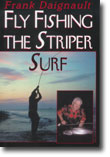Review: “Fly Fishing the Striper Surf”
FRANK DAIGNAULT has earned iconic status among the hard-fishing striper anglers of the U.S. northeast coast. He is the author of six books on striper fishing, including two that quickly became must-reads for the surf-casting set: Striper Surf (Globe Pequot, January 1996) and Eastern Tides: A Surfcaster’s Life (Burford Books, 2002), an anecdotal look at how the author’s life became intertwined with the pursuit of this incredible game fish.
In Fly Fishing the Striper Surf (Burford Books, May 2004), Daignault encapsulates almost 50 years of experience fly fishing for striped bass at night from the shores of southern Massachusetts. As in his other books, he stretches to include all beaches from Maine to New Jersey in his commentary, but he’s the first to admit his knowledge derives almost solely from fishing Cape Cod, which in fact is no limitation at all, since the area provides all the situational complexity required.
Listening to Daignault you hear some hard edges and more than a bit of salt-cured advice. Other reviewers have noted that this latest book from the author is a bit scattered in scope. On the other hand, there’s so much good advice wound up in the author’s trail of anecdotes and asides that it’s hard not to keep reading. Though not a striper fishing veteran myself, I was intrigued by Daignault’s hard-won insights and found myself returning to several sections because they contained observations that could be applied to most other saltwater fly fishing situations. For example — and this may be the area of the author’s greatest strength — whenever Daignault has an opportunity he correlates fish position and tide:
“Anytime an inlet has been reliable during the drop, and usually crowded as a result, there will be a percentage of the same fish in the currents of the incoming tide. This is a situation that calls for some discretion, but few anglers either feel comfortable on the incoming or are willing to fish both. They stay with what they know and you fish alone, which is fine with me.”
And like most anglers of long experience, he’s quick to debunk pseudo-science when it comes to locating fish and events:
“There is so much junk science regarding species of cinder worm, the most likely timing for a swarm, and suitable water temperatures that the subject of debunking the worm fairy-lore is bigger than the known body of knowledge on the worms themselves.”
The book approaches fly fishing for stripers from several angles – how to find them, what tackle to use, and a comprehensive look at fly patterns (Daignault doesn’t shrink from recommending patterns with the look of “hardware”). The backbone of the book is strategic advice: how to choose water, how to plan presentation based on striper behavior, how to “match the hatch.” The author chooses to include a chapter on current fly and non-fly striper records, which seems slightly out of place in a book about technique, and he ends the book with a chapter called “Fifty Years of Fly Fishing,” another incongruous passage that talks little about striper fishing but includes a fine collection of additional insights on everything from salmon to sea-run trout.
In all Daignault reads like a New England version of Stu Apte: willing to chafe a bit on dignity of the reader if it helps get the point across. If your preference is for sight-casting, you won’t find much encouragement here: Daignault believes fishing at night, and fishing from the beach, is the way to striper fish. But if you’re a keen enough angler, you’ll soak it all in, because the book reflects how one man has refined a pursuit almost to perfection.












